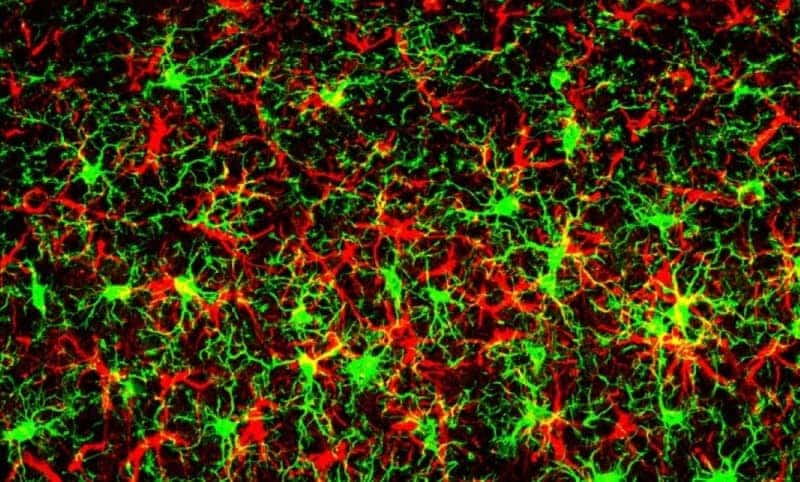Summary:
Scientists at UT Southwestern have identified the protein GADD45G as a master regulator of reactive gliosis, a damaging process in neurodegenerative diseases like Parkinson’s and Alzheimer’s, offering a potential new therapeutic target.
Three Key Takeaways:
- GADD45G triggers and spreads reactive gliosis, a stress response in glial cells that contributes to neuroinflammation, synapse loss, and neuronal death in neurodegenerative diseases.
- Suppressing Gadd45g in Alzheimer’s mouse models reduced brain inflammation, lowered amyloid-beta levels, and improved cognitive performance, suggesting a promising intervention point.
- The discovery positions GADD45G as a central control node in glial response pathways, opening the door to novel therapies that modulate harmful aspects of reactive gliosis.
University of Texas Southwestern Medical Center scientists have identified a protein that appears to act as a master control switch for reactive gliosis, a prominent feature of many neurodegenerative diseases that is thought to contribute to their pathology. The researchers’ findings, published in Neuron, could eventually lead to new treatments for Alzheimer’s, Parkinson’s, and Huntington’s diseases and other neurodegenerative conditions.
“Reactive gliosis can help the nervous system adapt to stressful conditions to continue healthy functioning, but it can also be maladaptive, even causing neuronal death. Learning how to control this condition could help us protect cells from the negative aspects of reactive gliosis, changing the trajectory of neurodegenerative disease,” said Chun-Li Zhang, PhD, Professor of Molecular Biology, a member of the Hamon Center for Regenerative Science and Medicine, and an investigator in the Peter O’Donnell Jr. Brain Institute at UT Southwestern. Dr Zhang co-led the study with first author Tianjin Shen, PhD, Research Scientist in the Zhang Lab.
More than half the volume of the central nervous system is made of glia, non-neuronal cells that support neurons by delivering nutrients, producing insulation, and removing pathogens and dead cells. Astrocytes and microglia are two common glial cell types. When the central nervous system becomes stressed through trauma or disease, these cells proliferate and grow larger, secreting protective proteins, absorbing harmful factors, and shoring up the blood-brain barrier, all hallmarks of reactive gliosis.
However, this condition also can have detrimental effects, Dr Zhang explained. Reactive gliosis can harm the connections between neurons, called synapses; restrict regeneration of axons, the long extensions on neurons; increase neuroinflammation; and prompt apoptosis, or programmed cell death. These negative aspects of reactive gliosis are thought to play a significant role in the pathology of neurodegenerative diseases.
Although researchers have identified several proteins involved in reactive gliosis, their production is believed to be regulated by genes further upstream in the molecular signaling cascade responsible for this condition. To search for this condition’s master controls, Dr Zhang and his colleagues searched a database of gene activity in the astrocytes of mice after these cells were exposed to a bacterial toxin that causes inflammation. They soon homed in on Gadd45g, a gene whose activity significantly increased in response to the toxin.
Gadd45g is part of a larger family of genes identified as stress sensors in cancer research, but its role in healthy astrocytes was unclear. To seek answers, the researchers worked with mice whose astrocytes were altered to overproduce GADD45G, the protein product of the Gadd45g gene. Not only did this modification spur reactive gliosis in astrocytes, but also in nearby unmodified cells. This suggested the astrocytes secreted chemical signals to prompt reactive gliosis in other cell types—a theory the researchers confirmed using genetically modified astrocytes growing in a petri dish with neurons. In both experiments, reactive gliosis prompted by the astrocytes decreased the number of neuronal synapses and triggered inflammation.
In a mouse model of severe Alzheimer’s disease, the researchers found increased activity of Gadd45g in the brain, supporting the idea that the gene instigates the reactive gliosis that accompanies this disease. Analysis of gene activity in people with Alzheimer’s confirmed this gene is upregulated in human patients as well. When the researchers genetically modified the model to produce more GADD45G, symptoms of the disease were dramatically worse than in unmodified models – their brains collected double the amount of pathological amyloid-beta protein and had significantly increased inflammation at an earlier age.
Conversely, selectively deleting Gadd45g in astrocytes significantly reduced the amount of amyloid-beta protein in the model. Additionally, down-regulating the gene enhanced cognition in the Alzheimer’s model, boosting performance in multiple tests of learning and memory.
Together, Dr Zhang said, these results suggest GADD45g serves as a master regulator of reactive gliosis. Finding ways to control its activity could eventually improve outcomes for Alzheimer’s and other neurodegenerative diseases.
Other UTSW researchers who contributed to this study are Wenjiao Tai, PhD, Instructor of Molecular Biology; Shuaipeng Ma, PhD, Xiaoling Zhong, PhD, and Yuhua Zou, MSc, Research Scientists; and Dongfang Jiang, PhD, postdoctoral researcher.
Dr Zhang is a W. W. Caruth Jr. Scholar in Biomedical research.
The study was funded by grants from the Texas Alzheimer’s Research and Care Consortium, the Decherd Foundation, and the National Institutes of Health (NS092616, NS127375, and NS117065).
Featured image: A fluorescent image displays reactive gliosis – a condition found in many neurodegenerative diseases – in the cerebral cortex induced by astrocyte-expressed GADD45G, the protein product of the Gadd45g gene. Reactive astrocytes are shown in red and reactive microglia are green, both common glial cell types. Photo: UT Southwestern





